Astronomers spot galaxy releasing gassy 'superwind'
Loading...
A striking galaxy buzzing with energetic star formation takes center stage in a new photograph that showcases an unusual "superwind" of out-flowing gas, researchers say.
The starburst galaxy NGC 4666, located about 80 million light-years away from Earth, is a hotbed of intense star formation, which is thought to be caused by gravitational interactions between NGC 4666 and its neighboring galaxies, one of which is visible in the lower left of the new photo. [See the galaxy NGC 4666 photo]
Gravitational interactions between galaxies often trigger the type of rigorous star formation seen in NGC 4666.
Strong winds from the massive stars inside NGC 4666, combined with supernova explosions, drive a robust flow of gas – a so-called "superwind" – from the galaxy into space, according to the European Southern Observatory where astronomers took the new photo.
The superwind originates in the bright central region of the galaxy and extends for tens of thousands of light-years. Astronomers think the cosmic wind could be blowing at speeds of up to a few thousands of kilometers every second, said astronomer Jörg Dietrich of the University of Michigan. The new photo of the galaxy was part of follow-up observations for an earlier study by Dietrich and his colleagues.
"Observing superwinds directly is difficult because the gas in them is very tenuous," Dietrich told SPACE.com in an e-mail. "However, these winds push denser and colder gas out, which is easier to observe."
The gas is very hot and emits radiation mostly in the form of X-rays and in the radio part of the spectrum, which cannot be seen in visible light images.
This new image of NGC 4666 was made in visible light with the Wide Field Imager on the MPG/ESO 2.2-meter telescope at the La Silla Observatory in Chile, which is part of the European Southern Observatory.
The galaxy had previously been observed in X-rays by the European Space Agency's XMM-Newton space telescope, and this image was taken to allow further study of other objects that had been detected in the earlier X-ray observations.
One such object is a faint galaxy cluster that can be seen close to the bottom edge of the image, to the right of center. This cluster, serendipitously found from the XMM-Newton observations, is much farther away from Earth than NGC 4666, at a distance of about 3 billion light-years.
In studying astronomical objects, researchers must observe them at several wavelengths, as light at different wavelengths can show different physical processes that are taking place.





